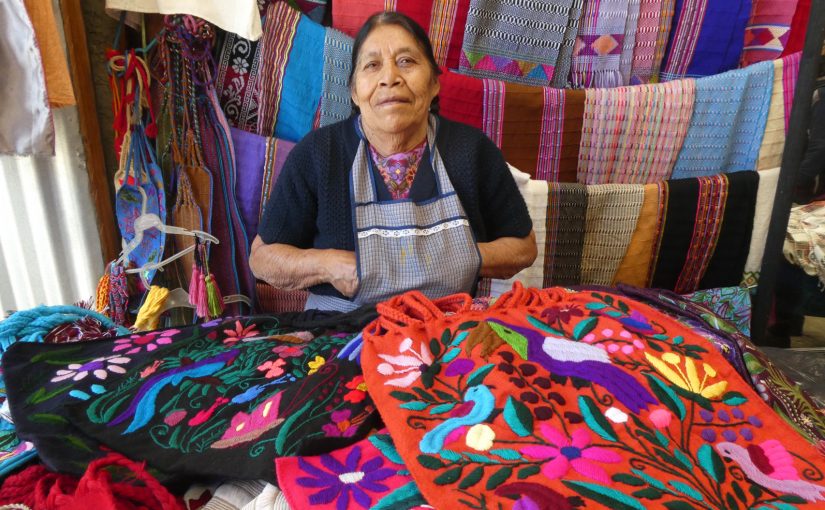I went to Mexico to learn about the Mayan civilisation, and I thought that the Mayans had mysteriously disappeared when their civilisation died out around 900 AD. But that isn’t true; the cities were abandoned and the civilisation collapsed, but the people lived on and are still thriving today in parts of Mexico, Belize, Guatemala, Honduras and El Salvador.
The Chiapas region in Southern Mexico is the most ethnic region of the country, and one of these ethnic groups is the Tzotzil, who are Mayans with their own language and religion. The religion is part Catholic, part Mayan, and involves Shamans, candles, mirrors and moonshine.
The Tzotzil wear traditional clothing made of sheepskin, black skirts for women and white tabards for men, which are hugely expensive and must be very hot in the Mexican climate –


definitely a touch of Catholicism in these outfits 

woman on the bus, standing in front of me
We visited the church of San Juan in Chamula, and our guide warned us beforehand not to take photos, and not even to have a camera visible, as the locals have been known to smash cameras if they see them. So I took a quick pic of the outside before hiding my camera away –

It looks very conventional, doesn’t it? Well, appearances can be deceiving …
The inside of the church has no seating and the floor is entirely covered in pine branches. There are candles everywhere – on the floor and on all the side tables in front of the pictures of the saints – as well as hundreds of mirrors.
Here are a few pictures I found online, taken by people who were either willing to risk getting their camera smashed or very confident of their ability to take a sneaky snap without getting caught –
We watched as families arrived, swept a portion of the floor clear of pine branches and stuck thirty or forty candles directly onto the floor and lit them. The candles were placed in lines in front of the Shaman, who sat with the family clustered around him or her on the floor. There were family groups everywhere, with some children on their phones but most participating in the rituals.
The locals have no truck with modern medicine, and come to church to be healed by the Shamans.
First the Shaman prays with the whole family and then cleanses the sick family member, using either a chicken or eggs (yes, the eternal question …) and I saw both forms of the ceremony. For the egg cure, the Shaman holds up a plastic bag full of eggs and then rubs it all over the body of the sick person. The eggs remain whole and they are simply used to draw the sickness out and then absorb it.
The chicken cure is much more dramatic and we stood and watched it unfolding, until one of the church wardens came and told us we had to keep walking and couldn’t stand still to watch. So we scuttled off and did a quick circuit of the church and then dawdled back past the chicken to watch the rest of the cure.
There was a whole family together, parents and children, and the Shaman sat cross-legged on the floor between the sick man and a woman who was holding a very resigned-looking chicken. The Shaman prayed aloud for about ten minutes, and then the woman handed him the chicken. The Shaman turned to the sick man, holding the chicken in both hands and began rubbing the chicken’s head all over him; I hoped that a nasty dose of salmonella wouldn’t worsen whatever it was that he was already suffering from.
We stood and stared, just waiting for what was coming next. The Shaman held the chicken out in front of him and pulled on its neck, stretching it to an improbable length, and then twisted it. He handed it back to the woman and then continued to pray and chant while the chicken twitched on the floor in a very distracting way for several minutes.
Finally they got out the moonshine. The local spirit is called pox, pronounced ‘posh’, and they drink it mixed with lemonade or coke. The idea is to chug it down and then burp or vomit onto the person being cleansed to help get rid of the evil spirits. The family produced bottles and jars of the stuff and passed it round to everyone in the family, who started necking it down – even quite small children, which I found alarming.
I tried some afterwards –

and can confirm that it is absolutely vile – no chance of pox’n’coke catching on as a new aperitif, in my opinion … not unless it’s found to cure Covid-19.
And that was my strange event – an incredible fusion of ancient and modern, of religion and paganism – and all going on with tourists wandering around, gawping and wishing they could take photos for their blogs.



